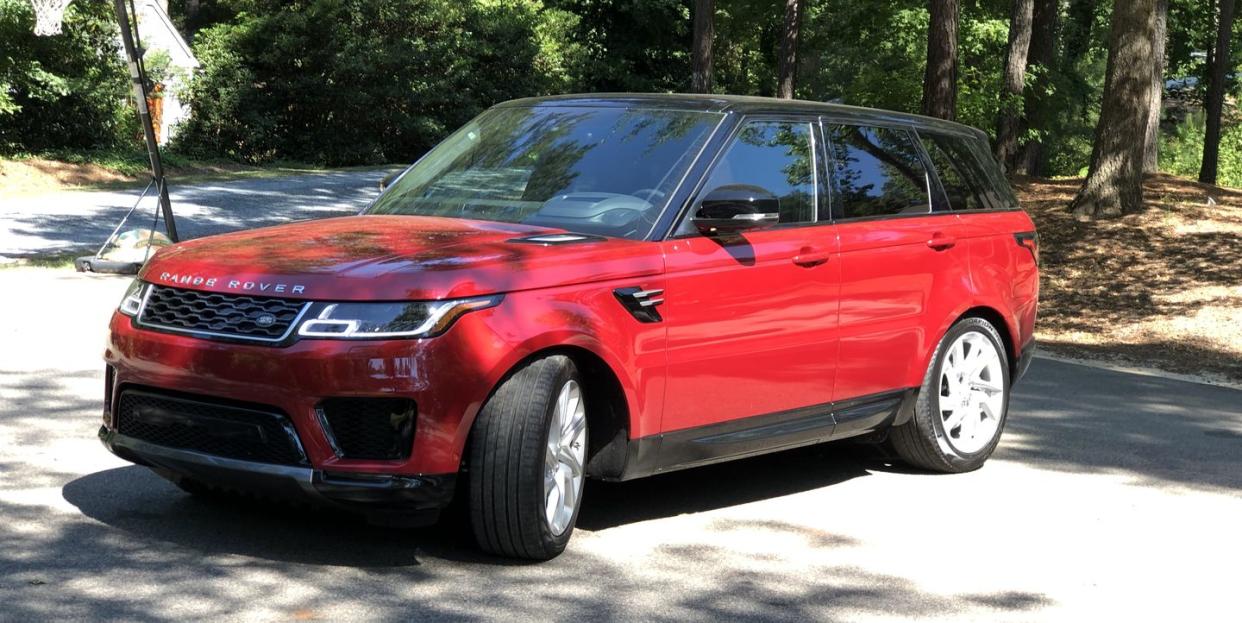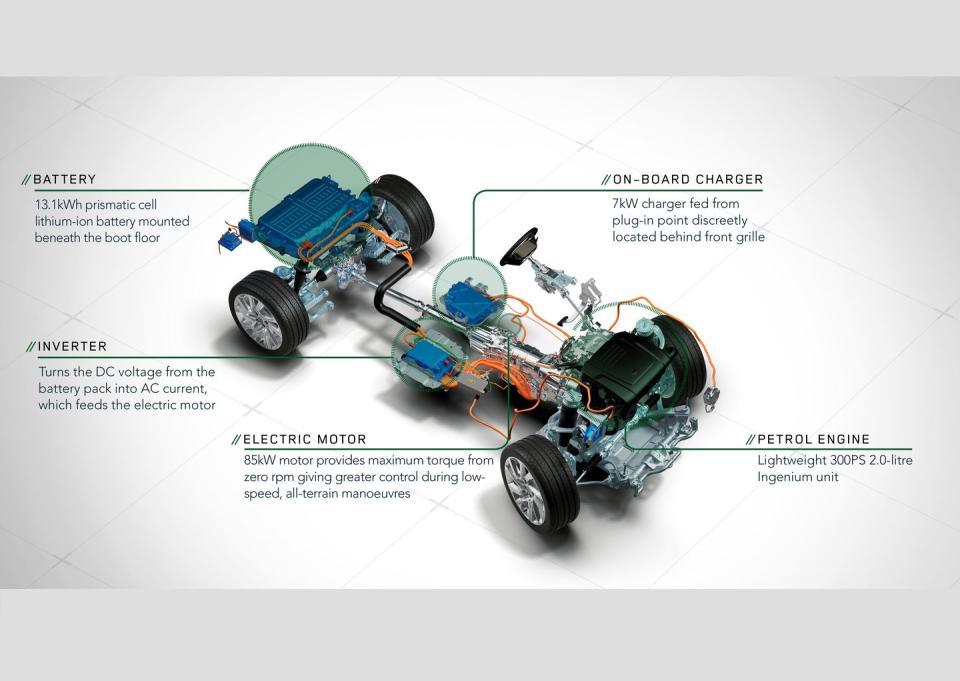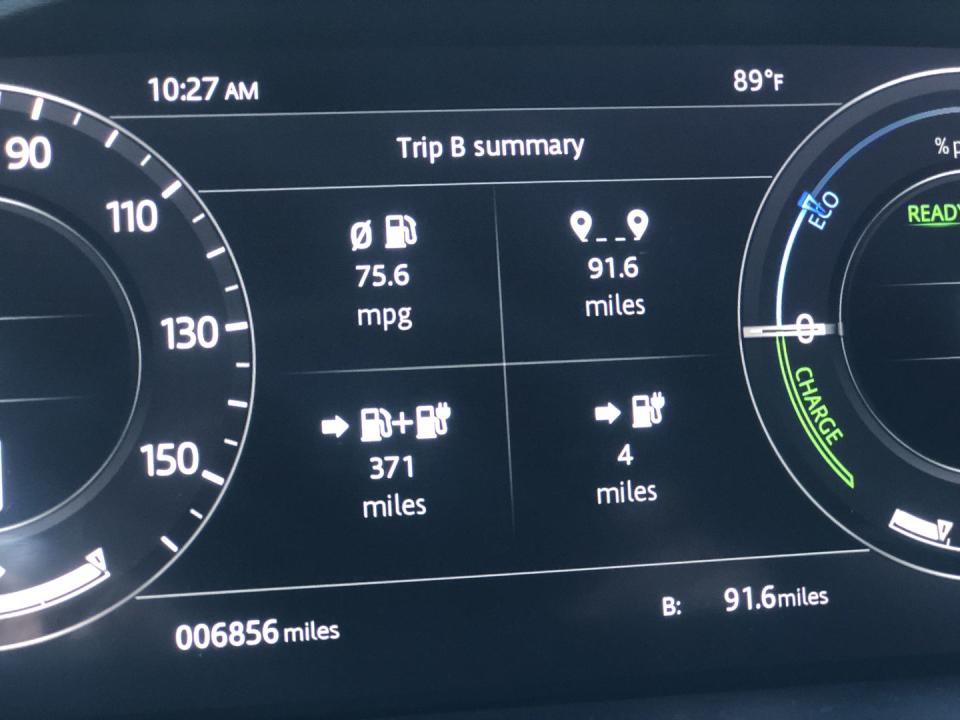I Got 75 Miles Per Gallon in a Range Rover

Engine and Motor: 2.0-liter I4, 296 hp and 295 lb-ft of torque; permanent magnet electric motor, 141 hp and 203 lb-ft of torque / Net Power: 398 hp and 472 lb-ft / Electric range: 31 miles /Battery: 13.1 kWh lithium ion / Transmission: 8-speed automatic with AWD and active rear differential / Base curb weight: 5,430 pounds / Max wading depth: 33.5 inches/ Top Speed: 137 mph (85 mph in electric mode) / Tow rating: 5,511 pounds / Base price: $79,000
As the trip odometer passed 90 miles, the fuel economy readout held steady at 75 mpg. By the time I parked, at 91.6 miles, the final number was 75.6 miles per gallon. That's an incredible number from any car, but all the more so from a huge, all-wheel-drive, fully luxed-out SUV.
The Range Rover Sport P400e can run from 0-60 in 6.3 seconds, tow more than 5,000 pounds and, in Land Rover fashion, handle itself off-road—its 33.5-inch max wading depth is slightly deeper than that of the 2020 Ford F-Series Super Duty with the Tremor off-road package.
Not bad for a hybrid.
So why not just make all Range Rovers like this? Why bother with any other kind of propulsion? Well, because the P400e's gaudy numbers come with some caveats. And frustrations.
The MPG Reality

First of all, that 75-mpg rating was not for a single trip. That was over several days of around-town driving with overnight charging in between. The Rover's 13.1 kWh battery is rated for 31 miles of EV-only range, but that's theoretical because the P400e never gives you full control over the disbursement of electrons.
There's a button for EV mode that's supposed to lock out the 2.0-liter turbo four-cylinder gas engine, but it's like the door-close button on elevators—you're often unclear whether it's really doing anything. You'll be sitting there at a red light, EV mode button lit, and suddenly the engine will burp to life governed by its own inscrutable logic.
In one attempt to extract max EV range, I had to pull over and restart the car to get it to quit running the gas engine. I was in EV mode, with an indicated eight miles of range, but the four-cylinder was nonetheless thrumming away under there.
It didn't matter if the Rover was in Eco mode and I was light on the throttle—some algorithm decided to run the engine, and the only way to clear that impulse was with a hard restart.
Going Electric
Despite some frustrating engine control issues, the P400e does work well in electric mode.
As opposed to Volvo's plug-in system, where the electric motor is barely strong enough to get the car moving on its own, the Rover uses a relatively robust 141-horsepower motor. Which, granted, isn't a lot of shove for a 5,500-pound SUV, but it'll get you around town and up to speed. Top speed in electric mode is 85 mph, so it's usable on the highway as well.
A gauge on the instrument cluster shows you how much throttle you can use before you trigger gas-powered assistance, and since the electric motor is packaged in the ZF transmission, you still get all-wheel-drive even when you're running on electric power. That's not always how it's done—the Volvo system, for instance, places the electric motor on the rear axle, so in EV mode the vehicle is rear-wheel-drive.
Keeping Things Charged

But most of the time, the P400e is operating as a parallel hybrid, blending electric power with gas. And whether that mode is gratifying or not depends on whether you charged the battery.
With a full charge, the Rover can lean more heavily on electric power and deliver great fuel economy along with all its other wondrous Range Rover Sport abilities. But deplete the battery and the P400e morphs into a regular old SUV. It doesn't drive any different, but fuel economy drops into the low 20s, and on a long trip I'm sure the 3.0-liter diesel Td6—which is about $4,000 less expensive—would crush it.
So whether the P400e makes sense all depends on how you use your car.
So yeah, 75 mpg is possible. That's great. But the P400e is its best self in electric mode—silent, smooth, efficient—and electric mode is fleeting youthful beauty when you've only got 13.1 kWh of battery.
The plug-in Range Rover Sport makes you wish that this company could build something like this, but with a huge battery and multiple electric motors. Something that went all-in on the electric benefits while casting away the internal-combustion crutches.
Oh, wait, they do: It's called the Jaguar i-Pace.
You Might Also Like

